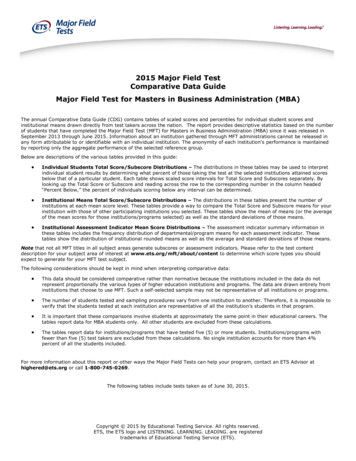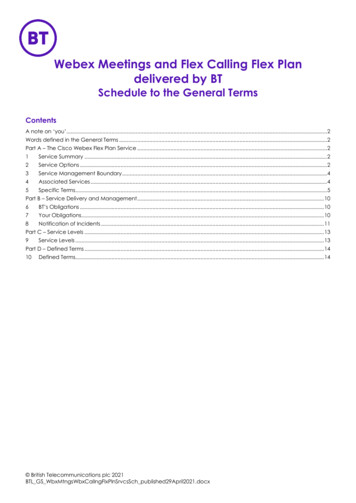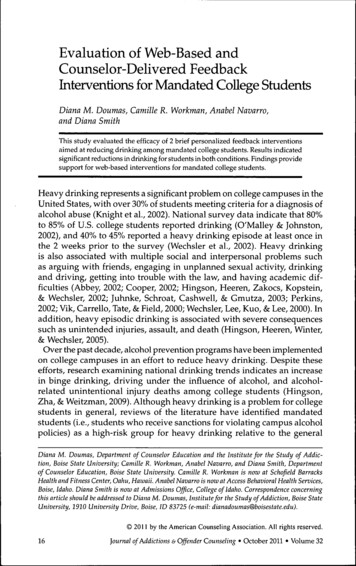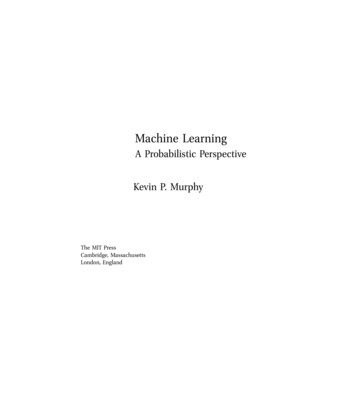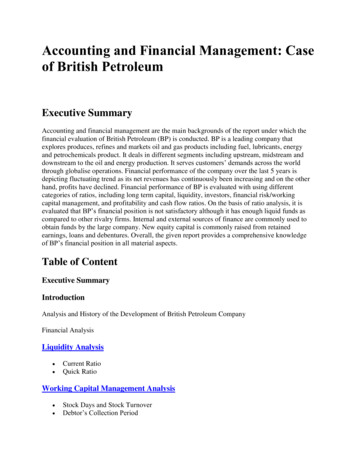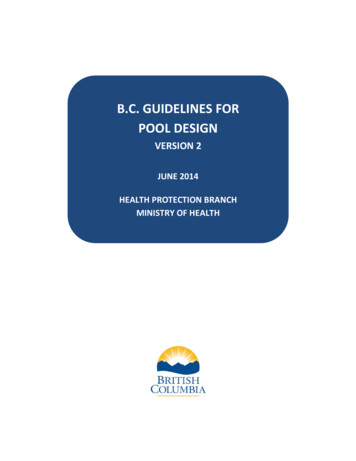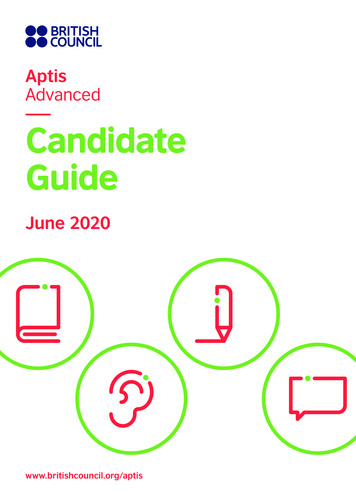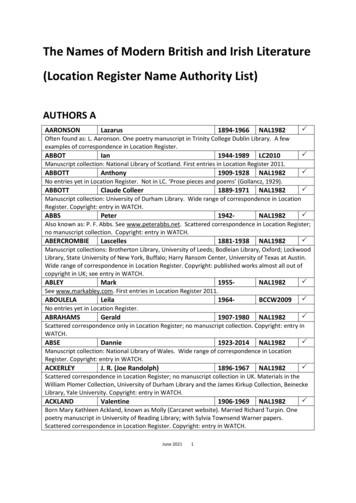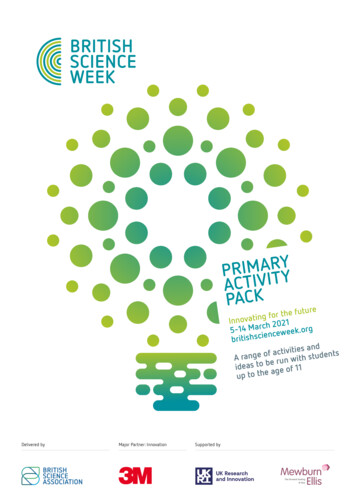
Transcription
YRAMIRPACTIVIT YPACKethe futurrofgintInnovach 2021 .orgraM415kienceweebritishscities and ntsivtcafoeA rangewith studnurebideas to ge of 11aup to theDelivered byManaged byMajor Partner: InnovationSupported by
InnovatingrfofuturetheThis activity pack is your ‘one-stopshop’ for supporting you duringBritish Science Week, but it can beused at any time. Feel free to adaptor extend the activities to suit yourpupils’ needs and the curriculum youare delivering.In addition to the activities in thispack, there are lots of other waysto enthuse and engage your pupilsthroughout British Science Week.In developing this pack, we havelooked for activities which break downthe stereotypes surrounding science,technology, engineering and maths(STEM) and promote cross-curricularlearning. We encourage you to useBritish Science Week as an opportunityto link STEM to other curriculumsubjects and to your pupils’ ownbackgrounds, lives and interests.2We understand that this academicyear is quite different for schoolsand we’ve adapted this pack to bestsupport you for British ScienceWeek 2021.This year, we’ve got some activities tocomplete in school, plus some whichare specifically designed for pupilsto take part in at home with theirfamilies.Please feel free to further adaptactivities within the pack to suit toyour setting, taking into considerationany quarantine of resources, workingin bubbles and social distancingneeded.We have also added in somesuggestions on remote engagementif you are unable to accommodatevisitors within your school.Find an activity near you:You can either create your own activityin your class or setting, or see whatactivities are happening near you. Lastyear we reached more than 180,000people. Help us make British ScienceWeek 2021 even bigger and better!Visit sciencelive.netEnter our competition:Some of the activities in this packcould be followed up by designinga poster; simply look out for thepaintbrush symbol shown above.The theme for this year’s postercompetition is ‘Innovating for thefuture’. For more information on thecompetition and how to enter, readon further in the activity pack orvisit britishscienceweek.org.
Introducing the themeMaking the most of volunteersBritish Science Week at homeGathering resources for classroom or homeBeyond the WeekUnlocking skillsGet children leading the wayTerrific ScientificHerd Immunity JengaSplit light into different coloursVisualising classrooms of the futureDoes the appearance of food affect how it tastes?Who invented blue?Build your own gut microbiomeGoing on a fact huntWhich plastic?Design your own Robo-bugSTEM Person of the WeekI’m a scientistBringing data to lifePoster competition3456789101113202123242629303235383941
InnovatingrfofuturetheIntroducingthe themeWhy not start British Science Weekoff with a bang, by introducingparents and pupils to the theme‘Innovating for the future’ in a funway to get them excited about theWeek ahead?Post your brilliant activity ideasor share images online taggingthe British Science Association onTwitter - @ScienceWeekUK - andusing the hashtag #BSW21Kick start the week with a simplebut impressive demo. Try a game,an audio-visual presentation,a mystery or special object, aninventor’s box or a pop-up displaywhich communicates the theme‘Innovating for the future.’Here is a video featuring the RubeGoldberg machine which you canshow the pupils. Anything thatinspires their inquisitive minds isan epic start.Get the pupils to put on theirthinking caps and experienceINNOVATION by asking them tocome up with machines they wouldlike to invent from readily availablescrap or craft materials in theclassroom or setting.Encourage the pupils to comeup with an acrostic poem forINNOVATION by asking them whatcomes to mind when they hear it.You can even turn their acrosticpoem into a jingle which you cansing with them throughout theweek to remember their own ideasabout innovation.Engage pupils into sharing howinnovation is a part of people,materials, animals, nature oranything else in their everydaylives.Invite a special guest or someonefrom the school community toengage the children with theirexperience of an innovation. Theycould highlight a special toolthat they use in their job anddemonstrate how it makes theirwork more efficient, or they couldfeature their favourite innovation.See Page 5 for information on howto get volunteers.Here are some other ideasto start the week:Tell the pupils about the plan forBritish Science Week and givethem a challenge related to thetheme. If you are sending homea family experiment, maybe youcould introduce/demo it at yoursetting first.Innovation is around us. Wherehas the topic of innovationbeen in the news or yourlocal area? Can you give anexample of innovation? Is thereany way you can encourageconversations with pupils aboutthis?Launch the poster competitionand let parents know about this(see Page 36 of this pack).4
Making the mostof volunteersOpportunities for face-to-faceengagement with external visitorsmay be limited this year, but thereare opportunities for gettingvolunteers and presenters to engageyour pupils online.5STEM Ambassadors offer their timeand enthusiasm to help bring scienceand technology subjects to life anddemonstrate the value of them in lifeand careers.Things that work well are to:1 Kick off British Science Weekwith a career talk/demo fromone of these inspiring volunteersto engage the pupils for therest of the week. The volunteercan highlight a useful tool orinnovation which they use intheir jobs and how it makes theirjob easier. Or, the volunteer canhighlight their favourite innovationto share what and why that is.The STEM Ambassador website hasrecently been updated to enableteachers to request online STEMAmbassador support. Any activitycreated has an ‘online’ check box aswell as a place to enter a link to avideo conferencing call if required.STEM Ambassadors from across theUK can respond to any online activityrequest. Find out more and make arequest here: www.stem.org.uk2 Schedule two or three differentguests for a career talk throughoutthe week if you can. This will keepchildren excited and anticipatingwho the next guest will be, andwhat they do. Opportunities likethis will likely inspire them aboutwhat they want to be in thefuture. Remember, they are nevertoo young to explore their careeroptions.You can also look for presentersand volunteers via Science Live(sciencelive.net) or ask parents if theywork in STEM related jobs to describewhat they do in more detail.3 Where available, choosevolunteers/ambassadors whochallenge stereotypes the pupilsmight have and promote positiveattitudes towards science -e.g. female engineers. Let thevolunteers/ambassadors share ina simplified talk how their job ismaking a difference in the world(or an anecdote of what scienceactivity they loved to do as a child).4 Book your visitors early (manyspeakers get booked up duringScience Week), have a clear ideaof what you want them to do andcommunicate this with them aheadof time.Volunteers come from a rangeof careers and experiences, fromengineers, designers and architectsto scientists and technicians, so getchildren excited about inspirationalcareer talks, broaden their choices anddevelop their interest in these careers!Visit Inspiring the Future’s websitefor some helpful ideas for usingvolunteers, some of which may betransferable when using remoteengagement.inspiringthefuture.org
British Science Weekat homeWant the pupils to get involved inBritish Science Week at home, butnot sure how? Here are our top tipsfor engaging parents and carers inthe Week:16Make the most of your parentnewsletters, the Parent-TeacherAssociation (PTA), chat group andtext messaging services if you havethem. Let all the parents know inadvance of the Week (at least amonth) what you have planned,and how you’d like them to beinvolved. They might be able tocollect/donate materials and storethem for use during the Week; andif you want them to get involvedin any experiments at home, theymay need time to plan and collectmaterials themselves. The PTA maybe able to support you financiallyto run the Week or help drum upparent volunteers.2 Get parents thinking about howtheir own jobs might link to STEMsubjects and encourage them tochat with their children about this.You could do this via a newsletteror send pupils home with activitiesthey can do with their parents,which may then lead onto furtherconversations. (See Page 12 for agreat take-home activity.)3 Encourage exploring outdoors, inthe community or in local culturalspots. This could be anything fromgoing on a nature walk aroundlocal parks to spotting STEM inaction on the streets around pupils’houses. Why not try out some ofthe CREST Award activities whichare quick and easy to do as fun,outdoor challenges too:library.crestawards.org4 Send an experiment idea homeduring the Week which mightspark mealtime discussions aroundSTEM.5 Try and make it as low-resourceas possible. It can help if it’ssomething the pupils have triedor seen at school first so that theyfeel like the ‘experts’ when theydo it at home with family, allowingthem to lead the learning.Crafty rafts from the CRESTSuperStar resources is ideal forthis: primarylibrary.crestawards.org.Why not try these fun science-basedactivities from the CREST at homeStar collection (collectionslibrary.crestawards.org) which can becompleted at home with fewresources? You could also use the‘Which plastic’ activity on Page 25 ofthis pack.
Gathering resourcesfor your classroom or homeIf you can, try to collect materialsall year round that can be cleanedand stored for use during BritishScience Week.Alternatively, check to see whetherthere is a scrap shop/store/clubopen in your local area. Theseshops are often membership basedand can be a brilliant, inexpensiveor free resource for card, plastic,bits of material – all sorts. Thesethings can be turned into forests,cars or model people; you name it,the kids will thinkof it!Look at childrensscrapstore.co.ukto find a UK directory of scrapstores.7Take photographs when out andabout and share these with thepupils to foster discussion andraise their level of understandingabout innovation – machines,materials, building structures,etc. The more colorful, the better.You can also use these photosfor an innovation version of theguessing game ‘I spy’ where youcan describe what the innovationis used for and the pupils willattempt to guess it.Collect story books and referencebooks linking to the theme‘Innovating for the future’ ahead oftime to create a themed library. Youcan even organise a read-aloudsession of a related story book forcircle or carpet time.
Beyond the WeekOnce British Science Week is over,this doesn’t mean the explorationand curiosity have to stop!Some ideas for keeping studentsengaged include:Pupils could take part in a CRESTAward. CREST is a scheme thatencourages young people to thinkand behave like scientists andengineers. Pupils can completeeight activities to achieve a Star orSuperStar Award which includes acertificate and badge.If there are older children at yourschool or in a school nearby theycould earn a higher level of CRESTtoo. For more information, take alook at the different CREST levelsavailable:crestawards.org/which-levelIf you have the opportunity, thenyou could consider running a STEMclub or curiosity lab within scienceclass or school. Find supportingresources at www.stem.org.uk.Consider sharing your BritishScience Week learnings by runninga CPD session for other teachersin your school or, where relevant,academy chain. Think aboutincorporating the Science Capitalteaching approach into yourmethods: ucl.ac.ukPRIMARYGetting started guideFind out how you can use CREST Star andSuperStar to give primary children their firstexperience of pupil-led problem-solvingchallenges set in a real-world context.Typical age: 5-11y:aCTiviTRaTsMplean eXal advenTuRedt, to finaand ouindoorsaniMploring!extsntarebichildr hastarrCeutneyvitd Activ ardAlaAnimtheing onare sitte bored.and GemCosmic frame. They arclimbingeplies. Hosmic reGem“OK,” C prowl arounda tiger.starts to ending to beetwhile pranimal readventuimalon an an“Let’s go outs Gem,shsafari!” down.jumpingGEMri,” saysend safa alt a pretim“No, no ean a real an s puzzled.mok“I,loicemmGtheure.” Cosadvent s Gem round gh, shewhiHe follo nd. She looks em to beseoutgrn’ayesfor.pllookingw but dolooks lo d what she isfinable toethere arid thats,Astro sa lled minibeast“UncleIcauts,“Bal.imlittle ansays Gemnd us,”tigersall arou any.”ns andesee on,n tiny liocan’tYou mea Cosmic. “Com us.”“Wow!kslpasgs?”can heinrothstdAanif Unclelet’s seeclethink Undo you em to look?Whereill tell thAstro wllenge812perStarEST SuEvery CR comes with aactivityCard toerOrganision.separate plan your sessuon whathelp yoes tipsludincneed,Itu might d toyotenequipm e time requirenthdiscussioas welld whatthrun it an u could use wiyoren.pointsthe childCOSMICreventu Cardal Ad Organiser’sAnimivitythe acthabitats.asts andAstroabout minibeture. Unclelow butthinkingl advenchildrenan anima looks high and for help.ed to getto go onAstrolly. Gemy is design. Gem wants look carefuask UncleThis activitshouldif theyare boredand Gem find minibeaststhinks theyCosmicCosmicthey willanimals.to:said that find any littlechildrensupportshe can’ty you willtsactivitthishabitaThroughand theirast huntthey seea minibeminibeasts Go onthe grouptheofout aboutthe rest Findgs withtheir findin ShareAboutasts)ng minibes for catchial devicet (your (specior pootel microscopeof old carpeting jarr digitapieces Collecs and/ostones,fying glasse (optional)logs, large Magni)bookwith rocks,ficationpreferably a few weeks earlier Identinment,dor envirothe groun Outdosome onncould placeinvestigatio.ct theirn to condu s of their resultsrt childrerecordor make5. Suppographstheir ownastand make also take phototo use a minibeon thestorythinkusing theThey couldThey might like find.where theyactivitywhat theyuce thedrawings.childrengs to theidentify1. Introd card. Ask thet their findin ve in theirguide toasts.activityn to presenas creatiment tofind minibethe childre , they can bethey willand equip6. Asky cardsthe grouphabitat.rest ofthey want.out activitastheirto2. Given.aastspresentationgoing onthe childreted minibewill beany collecn that they7. Returnand3. Explai ast hunt.s their ideastminiben to discusigations. Promprage childreinvest4. Encou carry out theirhow tominibeasts?make surewequestions: you look forwillHow will Where collect them? Will we harm them?we don’tKit listWhat todo13aYour chseeure andadvent n find.animalcaGo on an y animals youhow manGettheialsts ands in a reminibeacreatureals andith animgwingeus,skills Engantextscienceworld co eir practicalst’ andp thoters Develo g jars and po nimal’, ‘minibeacollectin rms such as ‘at wheres tens abou Discus rate’decisio‘inverteb communicate ight liveandsts meaib Makeinand manimalsCOSMICGEM
Unlocking skillsYou could engage the pupils in thisSTEM Person of the Week activity fromNUSTEM at Northumbria eativCo mentResilienReImaginlaba ti v eResili9g i n at i vrativeCreativginaImboeCollatCreativCreativc atuni oreemnicatorAs an alternative and a little bit ofmotivation, why not award each of thepupils with a sticker or certificate fora STEM skill which they identify withvery well during the Week?Ask the pupils to identify whatattributes people working inSTEM need. It might include beingobservant, creative, patient, a goodcommunicator, or curious.Co mmuSee the table below for the completelist developed by NUSTEM.eA fantastic way to encourage STEMinterest in pupils is to introducetransferable skills used by thoseworking in STEM jobs. These skillswill strengthen positive attitudestowards STEM and reduce theirstereotypes of those working in d-workingLogical
Get childrenleading the wayA great way to encourage STEMinterest in pupils is by letting themlead the way. Here’s how you canhelp them along:Encourage pupils to run their ownactivities during British ScienceWeek. They could either runactivities for other members ofthe class or run some CREST athome activities with their familyand take photos to present back totheir class. Find the resources here:collectionslibrary.crestawards.org10Get pupils running their own CRESTprojects and share what they’vedone through posters or show andtell.Ask pupils to research an inventionand how this influenced how welive our lives today and then writea report for the school newsletteror website.Encourage pupils to designand create their own display ofscientists through time – a photoexhibit of scientists who changedthe world with their discoveries,inventions and innovations.1
Innovating for the futureTerrific ScientificAbout this activityHow much electricity does yourschool use and how can you reducethat amount? By recording electricityusage over a period of days, you willlearn about how electricity is used,how it is wasted and what you can doto reduce this waste.9 7 2 3 8 4Week 11 Watch the introductory videoonline: bbc.co.ukTime1 hour to get started, then you’ll need10-15 minutes observation time everyday for 2 weeks.2 In your class, talk about how yourschool uses electricity.Which devices use electricity?Where are they?List as many of them as you can.Kit listClipboardPen/PencilThermometer(handle with care!)Computer to access thefollowing resources lectric DetectiveWorksheetPower Health Check TableElectricity Record SheetNext stepsThere are several interactiveactivities to try on the TerrificScientific website here.We also have tailored SENDresources available here.Watch out!Use caution when handlingthermometers as they arefragile.This investigation assumesthat all electrical equipmenthas been tested and passed assafe. Make sure your school hascarried out a risk assessmentfor this activity before you getstarted.Do not touch electricalequipment without a teacher’spermission or an adult present,and do not switch off anyequipment without an adult’spermission.Get an adult to supervise youwhen you read the electricitymeter. If it’s unsafe for you toread the meter, get an adult totake a photograph of it for you.Follow your school’s policy onsocial distancing when movingaround the school to helpreduce the risk of Covid-19transmission.When you’re recording outsideweather conditions, make sureyou don’t stare at the sun.11InstructionsThis activity takes place over 2 weeks.In week 1, you’ll discover how muchelectricity your school uses. In week 2,you’ll find ways to save electricity.3 In small groups, choose differentareas of school and complete theElectric Detective worksheet fordevices that use electricity in thatarea. Are these devices on, off, oron standby? Do they need to beon? Is power being wasted? Arethere windows open? Are hot tapsleft running?4 Using information from yourElectric Detectives worksheet, fill inthe Power Health Check table andwork out how energy efficient yourschool is.
Innovating for the futureTerrific Scientific5 With an adult, read your school’selectricity meter twice everyweekday – once in the morning,and once in the afternoon. Completethe Power Record sheet, subtractingthe morning reading from theafternoon reading to calculatehow much electricity your schoolused that day. Also record thetemperature inside and outside andthe amount of cloud cover to assesshow weather affects electricityusage. If the meter is not accessible,ask an adult to take a photo of it atthe same times each day.Week 21 Discuss what changes your schoolcould make to save electricity.Which devices could be switchedoff? Could lights be switched off?2 Start to make these changesaround the school and continueto take twice daily readings ofthe school’s electricity meter andrecord your data on the Powe
the British Science Association on Twitter - @ScienceWeekUK - and using the hashtag #BSW21 Kick start the week with a simple but impressive demo. Try a game, an audio-visual presentation, a mystery or special object, an inventor’s box or a pop-up display which communicates the theme ‘
